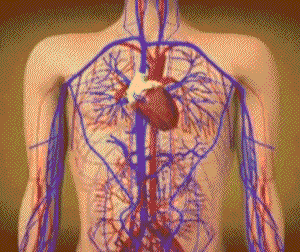The circulatory system is made of organs, such as the heart, blood vessels and lymph vessels that allow for the circulation of blood and lymph around the body. This system consists of the cardiovascular system as well as the lymphatic system.
The circulatory system has many functions and not just limited to the transport of nutrients to cells and waste away from cells. Some of the other functions inlcude:
- transport of hormones to target cells,
- helps in maintaining body temperature,
- maintain pH,
- fight disease.

Animals differ greatly in the structure of their circulatory systems, their different needs determines the best structure for the circulatroy system. Fish, for example, have a single circuit system, as shown on the right. Blood is pumped by the heart in one direction , first through the gills and on to the body. As blood travels throught the capillary system of the gills it reduces in pressure and arrives at the tissues very low in pressure. It is helped back to the heart by muscular action. This is why fish must keep moving in order to stay alive.
Amphibians, lizards, birds and mammals have a double circuit system. Where blood is pumped to the lungs and then returned back to the heart to be pumped to the body. This sytem maintains high blood pressure throughout the body.
The structure of the heart differs significantly from fish to amphibians to mammals and birds. Amphibians ahve a heart with only one ventricle allowing for mixing of oxygenated and deoxygenated blood. Mammals and birds, however, have two ventricles keeping deoxygenated and oxygenated blood separate.
